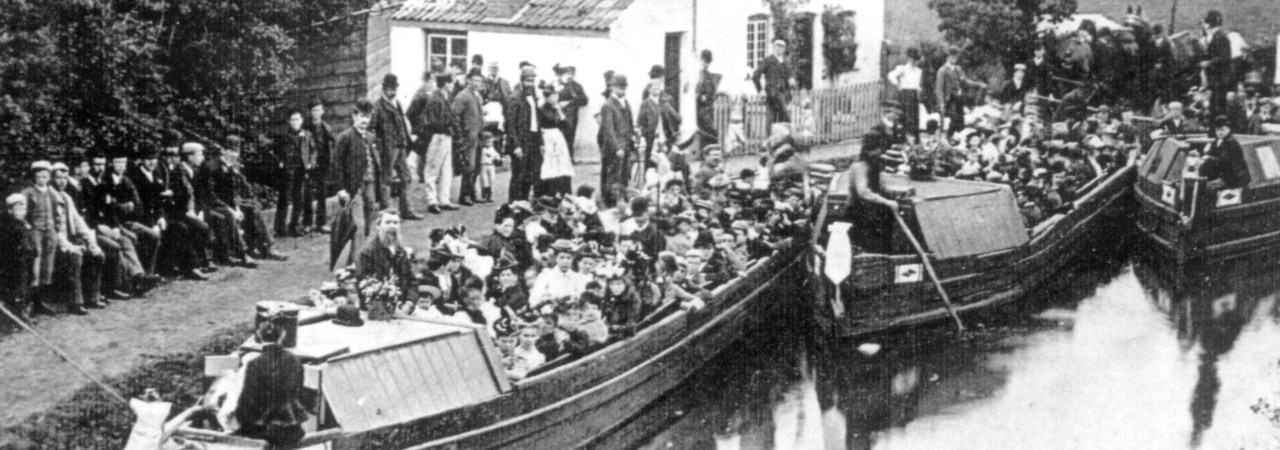The Monmouthshire, Brecon & Abergavenny Canals
The Monmouthshire and Brecon Canal (“Mon & Brec“) is a twentieth-century name for two eighteenth century Canals – the Monmouthshire Canal, and the Brecknock and Abergavenny Canal.
Introduction
The major problem facing British industry towards the end of the eighteenth century was transportation. The Industrial Revolution was based on coal which replaced timber as the main source of fuel. Small ‘cottage’ industries were replaced by bigger manufacturing industries. Roads were poor, so that the carriage of heavy or bulky goods was slow and expensive in man power.
Water was the alternative to road transport. In South Wales the rivers were not conducive to boat transport as they were relatively steeply inclined. The high ground to the north of the South Wales Valleys was rich in minerals. The twenty mile long ridge from Blaenavon to Hirwaun contained the iron, the limestone and the coal needed for the ‘new’ works. The English ironmasters who moved into the area were used to using canals to export their goods so naturally looked to similar facilities in the South Wales area.
The Monmouthshire Canal
The Monmouthshire Canal was granted its Act of Parliament in June 1792 for a canal from Pontnewynydd, north-west of Pontypool, via Pontymoile to Newport, known as the Main Line, and a branch from Crumlin to Malpas known as the Crumlin Arm or Branch. The Main Line was 11 miles long with 42 locks. 11 of those locks were on the 2 miles from Pontymoile to Pontnewynydd and that section was often short of water and it closed in 1854. The canal was built to carry coal and iron to Newport, and it led to a rapid expansion of the town and the riverside wharfs. The Crumlin Arm was also 11 miles long and had 32 locks lowering the canal by 358ft. The Cefn Flight of 14 locks at Rogerstone is one of the wonders of the British canal system.
Thomas Dadford Junior was the engineer for both parts of the Monmouthshire Canal, and for many of the associated tramroads.
The Main Line was operational by 1796, as was most of the Crumlin Arm which was fully operational by 1799.
With the exploitation of the coal in the area both branches of the canal were soon busy. By 1805 the terminus in Newport had become congested but not until 1808 was the canal extended to Friars Fields. Further work in 1812 extended the canal to Potter Street where a lock was built, separating the Company’s canal from the section owned by the Tredegar Wharf Company.
From the outset, tram roads or rail roads were an important part of the Company’s affairs and income. In December 1829 a locomotive started work on the Sirhowy tramroad. In 1845 a railway ( as today ) from Newport to Pontypool was finally completed. In 1848 the die was cast when it changed its name to The Monmouthshire Railway and Canal Company, hence MR&CC on some of the boundary markers. By 1854 the lower part of the canal was little used and the canal was closed as far as Llanarth Street. The released land was used for railway sidings – a sign of the times. In 1865 the Company bought the Brecknock and Abergavenny to safeguard the water supply to Newport Docks. However by this time the canals carried little more than general goods or short journey traffic, the coal and iron to Newport having transferred to the railways.
In 1875 the day-to-day running of the Company was transferred to GWR. In 1880 the ‘concern’ was bought by GWR and the two canals became known as The Monmouthshire and Brecon Canals. The last regular boat traffic was in 1915 and tolls were not collected after 1933 though working ( cargo carrying ) boats continued to use the canal until 1940s. The era of the canal as an industrial carrier had slowly but surely withered.
Just south of bridge 47 – Solomons Bridge – is the southern limit of the current Canal and River Trust (CRT) ownership. CRT is responsible for the navigable Monmouthshire and Brecon Canal. The remainder of the Monmouthshire Canal is now owned by Torfaen Borough, Newport City, or Caerphilly Borough Councils. See our Who Manages the Mon & Brec Canal page for more information.
The Brecknock and Abergavenny Canal
The Brecknock and Abergavenny Canal received its Act of Parliament in March 1793. The original idea was for a canal from Llanelly – now called Gilwern – to the River Usk at Newbridge to be called the Abergavenny Canal. The people of Breconshire, wishing to lower the price of coal in that area, called for the canal to be extended upwards from Llanelly to Brecon, and “Brecknock” was added to the original title.
The Monmouthshire Canal Committee heard of the proposal and offered £3,000 to the Brecknock and Abergavenny Canal to join their canal at Pontymoile, near Pontypool. They also altered their line to enable the junction.
1,000 shares of £100 were created with powers to raise a further £50 per share. One of the main shareholders was the Duke of Beaufort who owned much of the local land.
In stages the canal reached Brecon in December 1800 and so ‘the good people of Brecon’ could buy coal at around two thirds of the previous price.
The engineer of this section was Thomas Dadford Junior who was also the engineer on the Monmouthshire Canal.
Thomas Daford died on 2nd April 1801 and was buried at Llanarth, near Raglan.
When canal cutting started again at the end of 1802 the engineer involved was Thomas Cartwright. Govilon was reached by 1804.
The money had run out, and it was not until 1809 that work recommenced to complete the link with the Monmouthshire Canal. The engineer for this last section was William Crosley. It was not until 1812 that it finally joined the Monmouthshire Canal at Pontymoile near Pontypool, and so provided a through route to Newport and its river wharfs.
Previous to the link with the Monmouthshire Canal the main cargoes were coal, limestone, lime for agriculture or domestic purposes, and general goods. But the link up enabled iron goods to be taken from places such as Llanelly and Llanfoist right through to the docks at Newport. Tramroads were feeders to the Canal rather than a competitor.
The boats on the canal were 64ft 9in long including the rudder and 8ft 9in wide. The maximum load in theory was 25 tons but in practice seldom exceeded 20 tons.
By 1860s the railways crossing the canal at Talybont and Govilon had taken much of the coal trade and with iron and steel works moving nearer the coast most of the tonnage had gone. Lime kilns in the area were no longer important, and the canal had lost its main reasons for existence. By 1865 the shareholders had had enough and sold out to the Monmouthshire Company. A weekly general cargo boat from Newport to Brecon continued until 1915 and shorter, local journeys until the 1930s.
By then the era of the ‘working’ boat on this canal was over. In the late 1950s the leisure potential was realised. A weekly hire firm started in 1961, though rowing boats and canoes had been used since the early 1800s. Although a short length of the canal in Brecon was lost in the late 1960s the canal is currently open throughout its 33 mile length. There are now some 400 pleasure boats on the canal compared with about 60 boats in its working days.
Further information about the canal can be obtained on the Mon & Brec page in Wikipedia.
A very interesting, detailed history of the canal can be found on the Canal Routes website on their Monmouthshire and Brecon Canal history page.
Based on a work by Ray Haydon MBACT
Featured photograph at the top of this page – “Boat Trip, outside Tippin’s Cottage, Little Oak, on the Crumlin Arm” from the MBACT Archive. Do you know any thing about this photo? If you do please Contact Us.



